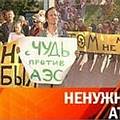 俄羅斯政府正計畫在莫斯科以東400公里處的下諾夫哥羅德州(Nizhny Novgorod)納瓦希諾區(Navashino)新建一座核能電廠。政府認為核電廠可生產電力又可增加就業機會,居民則憂心核廢料與輻射外洩問題。此計畫遭到36,000多名俄羅斯公民連署請願反對,環保人士22日已將請願書親手交到俄羅斯總統梅德韋傑夫手中。
俄羅斯政府正計畫在莫斯科以東400公里處的下諾夫哥羅德州(Nizhny Novgorod)納瓦希諾區(Navashino)新建一座核能電廠。政府認為核電廠可生產電力又可增加就業機會,居民則憂心核廢料與輻射外洩問題。此計畫遭到36,000多名俄羅斯公民連署請願反對,環保人士22日已將請願書親手交到俄羅斯總統梅德韋傑夫手中。
連署的公民來自核電廠預定地方圓30公里內的居民,其中多數來自鄰近奧卡河盼的穆羅姆市(Murom)。
環保人士於遞交請願書前,在莫斯科獨立媒體中心舉辦一場記者會,向媒體展示請願內容。會中穆羅姆市議會代表佛卡耶夫(Vasily Vakhlyaev)指出,民調顯示有95%穆羅姆市民強力反對核電廠距離過短。
該電廠將裝設兩座1170MW反應爐,預計每年供電170億度電,長期而言可提供1000名就業機會。首座反應爐預計於2017年啟用。
反核團體Ecodefense成員斯力耶克(Vladimir Slivyak)在記者會中指出此案存在許多問題:
首先,核廢料處置計畫不明。他指出,「根據計畫書,用過核燃料將送往『再生工廠』,但所謂再生工廠目前既不存在,也沒有興建的打算……高階核廢料的危險期約可維持24萬年,且沒有任何安全的貯存技術,很可能就永久存放在下諾夫哥羅德州。因此,該討論的問題應該有兩個:核反應爐與核廢料貯存場。」
其次,核電預定場址為喀斯特地質區,可能導致此地質損壞或崩毀。
批評者指出,核電計劃書也未見核燃料運送的相關影響評估數據,具體的反應爐除役年限,以及地區發展的其他替代方案分析。此外,也欠缺電廠正常運轉期間的氚、碳-14等放射性同位素的排放量計算。而這些都是環境影響評估的重要部份。
斯力耶克說,「我們必須讓聯邦官員落實公共參與法律。在本案中,這意味著停建此一危險、昂貴、又附帶核廢與輻射物質排放問題的核電廠。如果在俄國採用最新的省能技術,將可省下全國核電廠發電容量總和的兩倍電力。」
俄羅斯科學院雅布羅科夫教授(Alexey Yablokov)在記者會中指出,「核能直接影響罹病率與死亡率,德國等許多國家的研究以證明這一點。」他表示,只要全國更換省電燈泡,可省下的足夠的電力而不必蓋核電廠。
他呼籲,整個計畫「危險、昂貴,效益又低」,應該全部取消。
More than 36,000 Russian citizens have signed a petition protesting the planned construction of a nuclear power plant in the Nizhny Novgorod region east of Moscow.
Environmentalists handed the signed petition to the office of Russian President Dmitry Medvedev on Tuesday.
The government views the facility as a source jobs and electricity; residents worry about nuclear waste and radioactive emissions.
The signatures were collected among the inhabitants of the 30 kilometer (20 mile) zone around the proposed construction site, in the Navashino district, about 400 kilometers (250 miles) to the east of Russia's capital. More signatures were collected in the nearby town of Murom on the Oka River.
Before handing the signatures to the administration, the environmentalists presented them to the media at the Independent Press-Center in Moscow.
At the press conference, Murom City Council Member Vasily Vakhlyaev said the results of a public opinion poll indicate that 95 percent of the Murom residents strictly oppose the construction of the nuclear power plant so close to their town.
The plant will have two 1,170 megawatt reactors and is designed to generate over 17 billion kilowatt hours a year and employ as many as 1,000 people in the long term. The first reactor is planned for launch in 2017.
Vladimir Slivyak of the nonprofit anti-nuclear organization Ecodefense said at the press conference that there are many problems with the proposed nuclear plant.
First, he said, plans for treatment of nuclear waste from the power plant are unclear. "According to the project documentation, spent nuclear fuel will be transported to a 'regeneragion plant' which does not exist and is not planned to be built."
"Thus, said Slivyak, "high-level radioactive waste which will present danger for at least 240,000 years and for which there is no safe disposal technology, may remain in Nizhny Novgorod region forever. So, what is actually under discussion – a nuclear reactor or nuclear waste dumping site? It looks like both."
The proposed construction site is located in a region of karst rocks. Slivyak warns that siting a nuclear power plant there "may lead to karst rocks failures and collapses."
The project materials are missing such data as an analysis of nuclear fuel transportation that will affect the region, reactor decommissioning at the end of its lifecycle, and an analysis of the regional development option without a nuclear power plant, the critics point out.
Neither is there a calculation of the emission of such radioactive isotopes as tritium and carbon-14 during regular operation of the plant, they warn.
All this information is an essential part of the Environmental Impact Assessment.
"It's necessary to push federal officials to follow the legislation on public participation," said Slivyak. "In this case, that would mean stopping construction of a dangerous and expensive nuclear plant which will produce nuclear waste and release radioactive substances even at normal operation. Implementation of up-to-date energy efficiency and saving technologies in Russia would save twice more energy that all of country's nuclear reactors produces today."
"Nuclear energy has a direct effect on sickness and death rates," said Professor Alexey Yablokov of the Russian Academy of Science at the press conference. "This is proven by various research data in Germany and other countries."
Yablokov said that a simple nationwide switch to energy-efficient light bulbs would save so much energy that new nuclear reactors will not be needed.
Yablokov called for cancellation of the entire nuclear energy development program in Russia as "dangerous, expensive, and ineffective."
全文及圖片詳見:ENS





